Aboriginal Healthcare: Wellbeing, Medical Services and WHO Principles
VerifiedAdded on 2022/09/08
|9
|2787
|19
Essay
AI Summary
This essay delves into the concept of social and emotional wellbeing within Aboriginal communities, contrasting it with conventional mental health perspectives. It highlights the holistic nature of Aboriginal wellbeing, emphasizing its connection to land, culture, and community. The essay then explores Aboriginal Medical Services (AMS) and their alignment with World Health Organization (WHO) primary health principles, showcasing how these services provide culturally competent care. It examines the benefits of integrating social and emotional wellbeing approaches into the Australian healthcare system, advocating for a shift from treating mental illness to promoting overall wellbeing. The essay also discusses the potential challenges and benefits of applying AMS models nationally, emphasizing the importance of cultural competency and community control in healthcare delivery. It concludes by underscoring the value of AMS in improving health outcomes and fostering a more inclusive healthcare system for Aboriginal Australians.
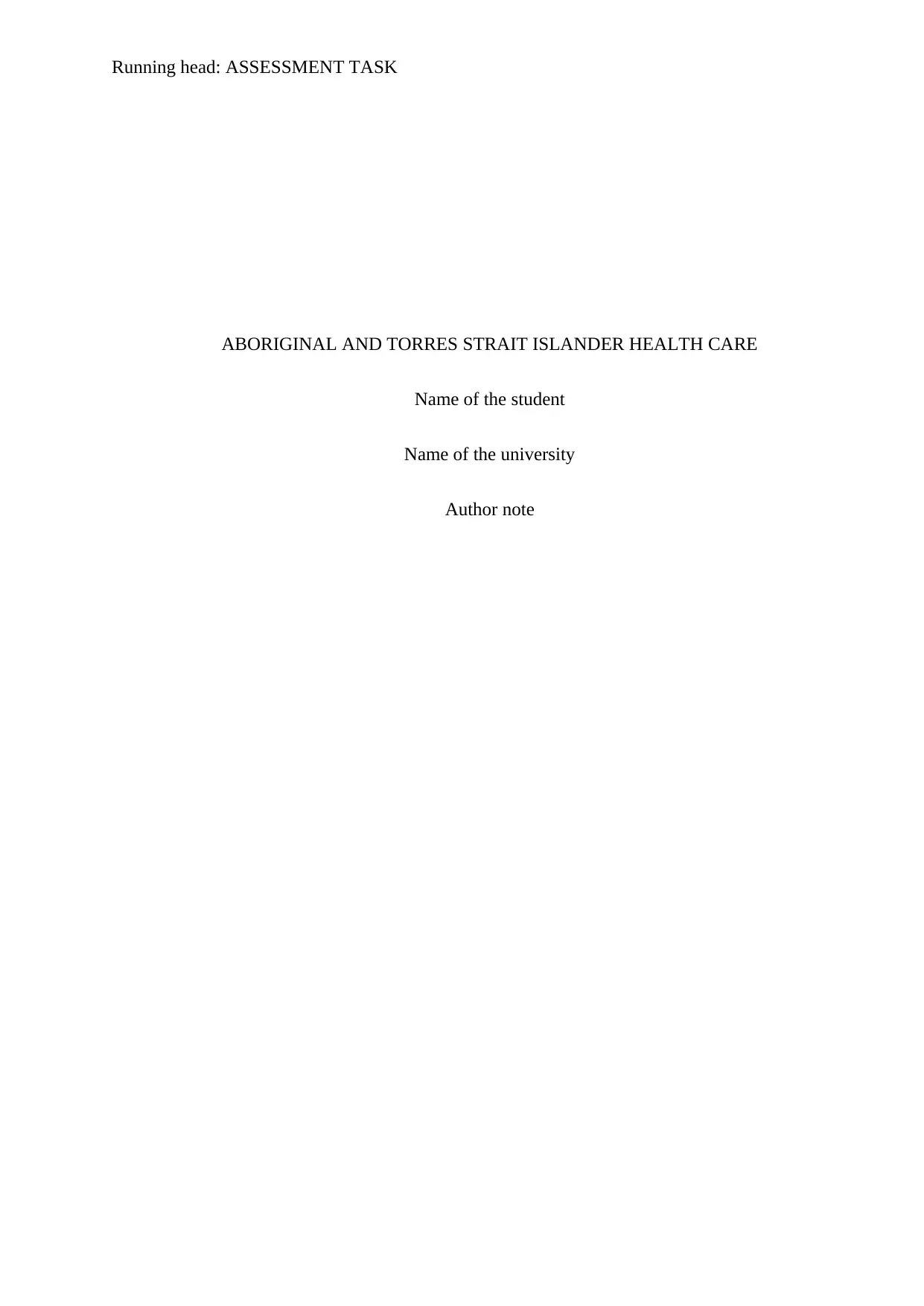
Running head: ASSESSMENT TASK
ABORIGINAL AND TORRES STRAIT ISLANDER HEALTH CARE
Name of the student
Name of the university
Author note
ABORIGINAL AND TORRES STRAIT ISLANDER HEALTH CARE
Name of the student
Name of the university
Author note
Paraphrase This Document
Need a fresh take? Get an instant paraphrase of this document with our AI Paraphraser
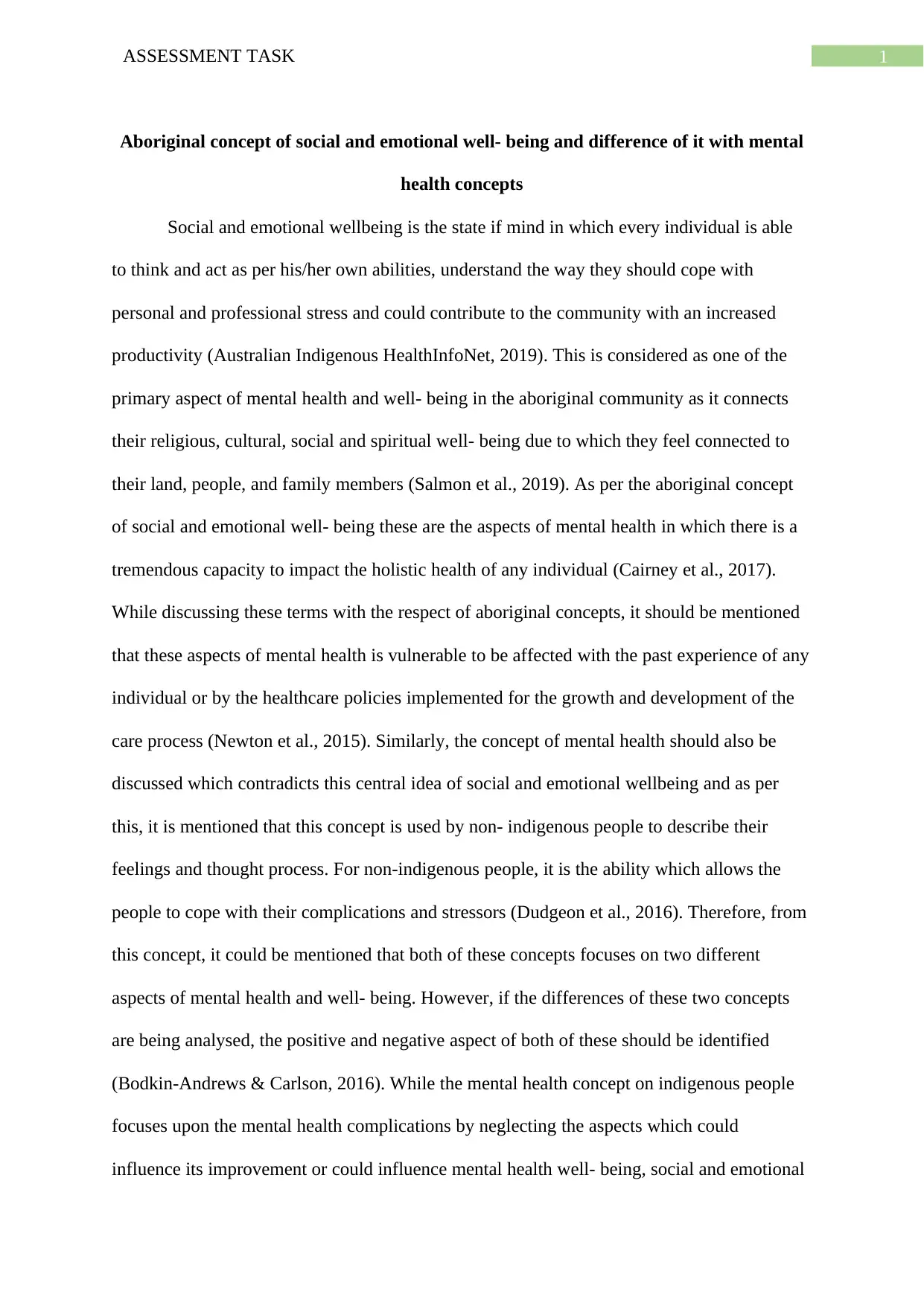
1ASSESSMENT TASK
Aboriginal concept of social and emotional well- being and difference of it with mental
health concepts
Social and emotional wellbeing is the state if mind in which every individual is able
to think and act as per his/her own abilities, understand the way they should cope with
personal and professional stress and could contribute to the community with an increased
productivity (Australian Indigenous HealthInfoNet, 2019). This is considered as one of the
primary aspect of mental health and well- being in the aboriginal community as it connects
their religious, cultural, social and spiritual well- being due to which they feel connected to
their land, people, and family members (Salmon et al., 2019). As per the aboriginal concept
of social and emotional well- being these are the aspects of mental health in which there is a
tremendous capacity to impact the holistic health of any individual (Cairney et al., 2017).
While discussing these terms with the respect of aboriginal concepts, it should be mentioned
that these aspects of mental health is vulnerable to be affected with the past experience of any
individual or by the healthcare policies implemented for the growth and development of the
care process (Newton et al., 2015). Similarly, the concept of mental health should also be
discussed which contradicts this central idea of social and emotional wellbeing and as per
this, it is mentioned that this concept is used by non- indigenous people to describe their
feelings and thought process. For non-indigenous people, it is the ability which allows the
people to cope with their complications and stressors (Dudgeon et al., 2016). Therefore, from
this concept, it could be mentioned that both of these concepts focuses on two different
aspects of mental health and well- being. However, if the differences of these two concepts
are being analysed, the positive and negative aspect of both of these should be identified
(Bodkin-Andrews & Carlson, 2016). While the mental health concept on indigenous people
focuses upon the mental health complications by neglecting the aspects which could
influence its improvement or could influence mental health well- being, social and emotional
Aboriginal concept of social and emotional well- being and difference of it with mental
health concepts
Social and emotional wellbeing is the state if mind in which every individual is able
to think and act as per his/her own abilities, understand the way they should cope with
personal and professional stress and could contribute to the community with an increased
productivity (Australian Indigenous HealthInfoNet, 2019). This is considered as one of the
primary aspect of mental health and well- being in the aboriginal community as it connects
their religious, cultural, social and spiritual well- being due to which they feel connected to
their land, people, and family members (Salmon et al., 2019). As per the aboriginal concept
of social and emotional well- being these are the aspects of mental health in which there is a
tremendous capacity to impact the holistic health of any individual (Cairney et al., 2017).
While discussing these terms with the respect of aboriginal concepts, it should be mentioned
that these aspects of mental health is vulnerable to be affected with the past experience of any
individual or by the healthcare policies implemented for the growth and development of the
care process (Newton et al., 2015). Similarly, the concept of mental health should also be
discussed which contradicts this central idea of social and emotional wellbeing and as per
this, it is mentioned that this concept is used by non- indigenous people to describe their
feelings and thought process. For non-indigenous people, it is the ability which allows the
people to cope with their complications and stressors (Dudgeon et al., 2016). Therefore, from
this concept, it could be mentioned that both of these concepts focuses on two different
aspects of mental health and well- being. However, if the differences of these two concepts
are being analysed, the positive and negative aspect of both of these should be identified
(Bodkin-Andrews & Carlson, 2016). While the mental health concept on indigenous people
focuses upon the mental health complications by neglecting the aspects which could
influence its improvement or could influence mental health well- being, social and emotional
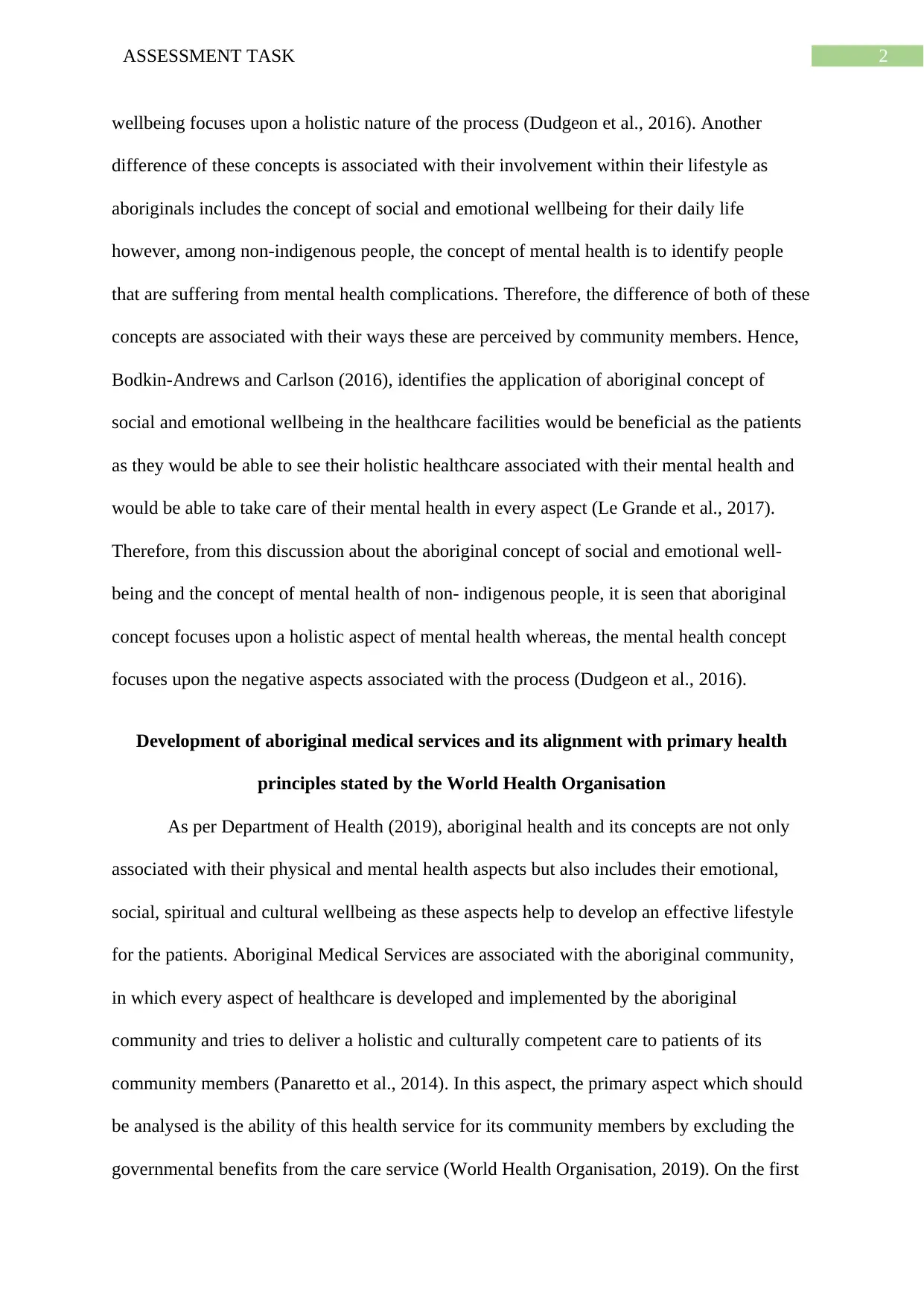
2ASSESSMENT TASK
wellbeing focuses upon a holistic nature of the process (Dudgeon et al., 2016). Another
difference of these concepts is associated with their involvement within their lifestyle as
aboriginals includes the concept of social and emotional wellbeing for their daily life
however, among non-indigenous people, the concept of mental health is to identify people
that are suffering from mental health complications. Therefore, the difference of both of these
concepts are associated with their ways these are perceived by community members. Hence,
Bodkin-Andrews and Carlson (2016), identifies the application of aboriginal concept of
social and emotional wellbeing in the healthcare facilities would be beneficial as the patients
as they would be able to see their holistic healthcare associated with their mental health and
would be able to take care of their mental health in every aspect (Le Grande et al., 2017).
Therefore, from this discussion about the aboriginal concept of social and emotional well-
being and the concept of mental health of non- indigenous people, it is seen that aboriginal
concept focuses upon a holistic aspect of mental health whereas, the mental health concept
focuses upon the negative aspects associated with the process (Dudgeon et al., 2016).
Development of aboriginal medical services and its alignment with primary health
principles stated by the World Health Organisation
As per Department of Health (2019), aboriginal health and its concepts are not only
associated with their physical and mental health aspects but also includes their emotional,
social, spiritual and cultural wellbeing as these aspects help to develop an effective lifestyle
for the patients. Aboriginal Medical Services are associated with the aboriginal community,
in which every aspect of healthcare is developed and implemented by the aboriginal
community and tries to deliver a holistic and culturally competent care to patients of its
community members (Panaretto et al., 2014). In this aspect, the primary aspect which should
be analysed is the ability of this health service for its community members by excluding the
governmental benefits from the care service (World Health Organisation, 2019). On the first
wellbeing focuses upon a holistic nature of the process (Dudgeon et al., 2016). Another
difference of these concepts is associated with their involvement within their lifestyle as
aboriginals includes the concept of social and emotional wellbeing for their daily life
however, among non-indigenous people, the concept of mental health is to identify people
that are suffering from mental health complications. Therefore, the difference of both of these
concepts are associated with their ways these are perceived by community members. Hence,
Bodkin-Andrews and Carlson (2016), identifies the application of aboriginal concept of
social and emotional wellbeing in the healthcare facilities would be beneficial as the patients
as they would be able to see their holistic healthcare associated with their mental health and
would be able to take care of their mental health in every aspect (Le Grande et al., 2017).
Therefore, from this discussion about the aboriginal concept of social and emotional well-
being and the concept of mental health of non- indigenous people, it is seen that aboriginal
concept focuses upon a holistic aspect of mental health whereas, the mental health concept
focuses upon the negative aspects associated with the process (Dudgeon et al., 2016).
Development of aboriginal medical services and its alignment with primary health
principles stated by the World Health Organisation
As per Department of Health (2019), aboriginal health and its concepts are not only
associated with their physical and mental health aspects but also includes their emotional,
social, spiritual and cultural wellbeing as these aspects help to develop an effective lifestyle
for the patients. Aboriginal Medical Services are associated with the aboriginal community,
in which every aspect of healthcare is developed and implemented by the aboriginal
community and tries to deliver a holistic and culturally competent care to patients of its
community members (Panaretto et al., 2014). In this aspect, the primary aspect which should
be analysed is the ability of this health service for its community members by excluding the
governmental benefits from the care service (World Health Organisation, 2019). On the first
⊘ This is a preview!⊘
Do you want full access?
Subscribe today to unlock all pages.

Trusted by 1+ million students worldwide
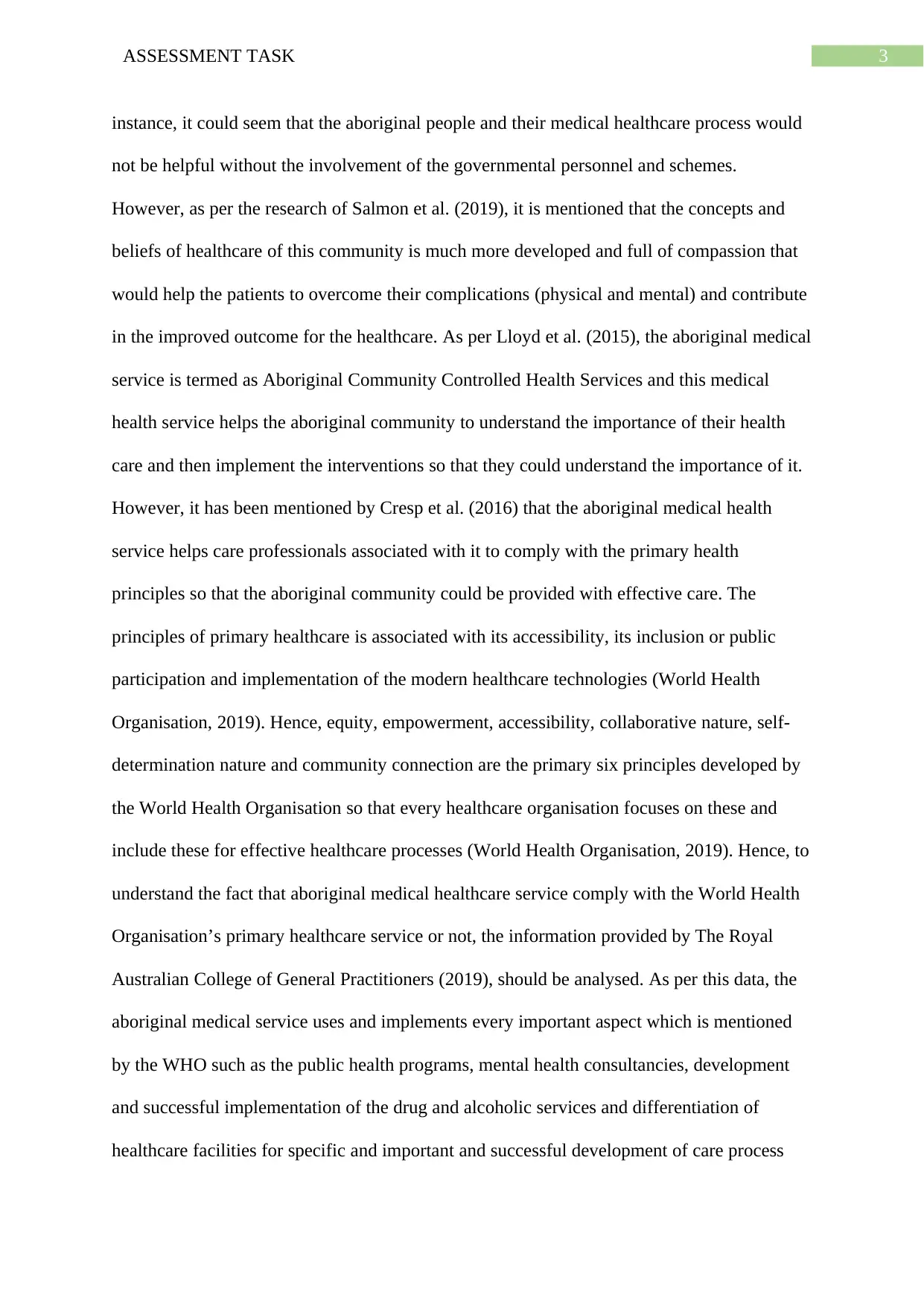
3ASSESSMENT TASK
instance, it could seem that the aboriginal people and their medical healthcare process would
not be helpful without the involvement of the governmental personnel and schemes.
However, as per the research of Salmon et al. (2019), it is mentioned that the concepts and
beliefs of healthcare of this community is much more developed and full of compassion that
would help the patients to overcome their complications (physical and mental) and contribute
in the improved outcome for the healthcare. As per Lloyd et al. (2015), the aboriginal medical
service is termed as Aboriginal Community Controlled Health Services and this medical
health service helps the aboriginal community to understand the importance of their health
care and then implement the interventions so that they could understand the importance of it.
However, it has been mentioned by Cresp et al. (2016) that the aboriginal medical health
service helps care professionals associated with it to comply with the primary health
principles so that the aboriginal community could be provided with effective care. The
principles of primary healthcare is associated with its accessibility, its inclusion or public
participation and implementation of the modern healthcare technologies (World Health
Organisation, 2019). Hence, equity, empowerment, accessibility, collaborative nature, self-
determination nature and community connection are the primary six principles developed by
the World Health Organisation so that every healthcare organisation focuses on these and
include these for effective healthcare processes (World Health Organisation, 2019). Hence, to
understand the fact that aboriginal medical healthcare service comply with the World Health
Organisation’s primary healthcare service or not, the information provided by The Royal
Australian College of General Practitioners (2019), should be analysed. As per this data, the
aboriginal medical service uses and implements every important aspect which is mentioned
by the WHO such as the public health programs, mental health consultancies, development
and successful implementation of the drug and alcoholic services and differentiation of
healthcare facilities for specific and important and successful development of care process
instance, it could seem that the aboriginal people and their medical healthcare process would
not be helpful without the involvement of the governmental personnel and schemes.
However, as per the research of Salmon et al. (2019), it is mentioned that the concepts and
beliefs of healthcare of this community is much more developed and full of compassion that
would help the patients to overcome their complications (physical and mental) and contribute
in the improved outcome for the healthcare. As per Lloyd et al. (2015), the aboriginal medical
service is termed as Aboriginal Community Controlled Health Services and this medical
health service helps the aboriginal community to understand the importance of their health
care and then implement the interventions so that they could understand the importance of it.
However, it has been mentioned by Cresp et al. (2016) that the aboriginal medical health
service helps care professionals associated with it to comply with the primary health
principles so that the aboriginal community could be provided with effective care. The
principles of primary healthcare is associated with its accessibility, its inclusion or public
participation and implementation of the modern healthcare technologies (World Health
Organisation, 2019). Hence, equity, empowerment, accessibility, collaborative nature, self-
determination nature and community connection are the primary six principles developed by
the World Health Organisation so that every healthcare organisation focuses on these and
include these for effective healthcare processes (World Health Organisation, 2019). Hence, to
understand the fact that aboriginal medical healthcare service comply with the World Health
Organisation’s primary healthcare service or not, the information provided by The Royal
Australian College of General Practitioners (2019), should be analysed. As per this data, the
aboriginal medical service uses and implements every important aspect which is mentioned
by the WHO such as the public health programs, mental health consultancies, development
and successful implementation of the drug and alcoholic services and differentiation of
healthcare facilities for specific and important and successful development of care process
Paraphrase This Document
Need a fresh take? Get an instant paraphrase of this document with our AI Paraphraser
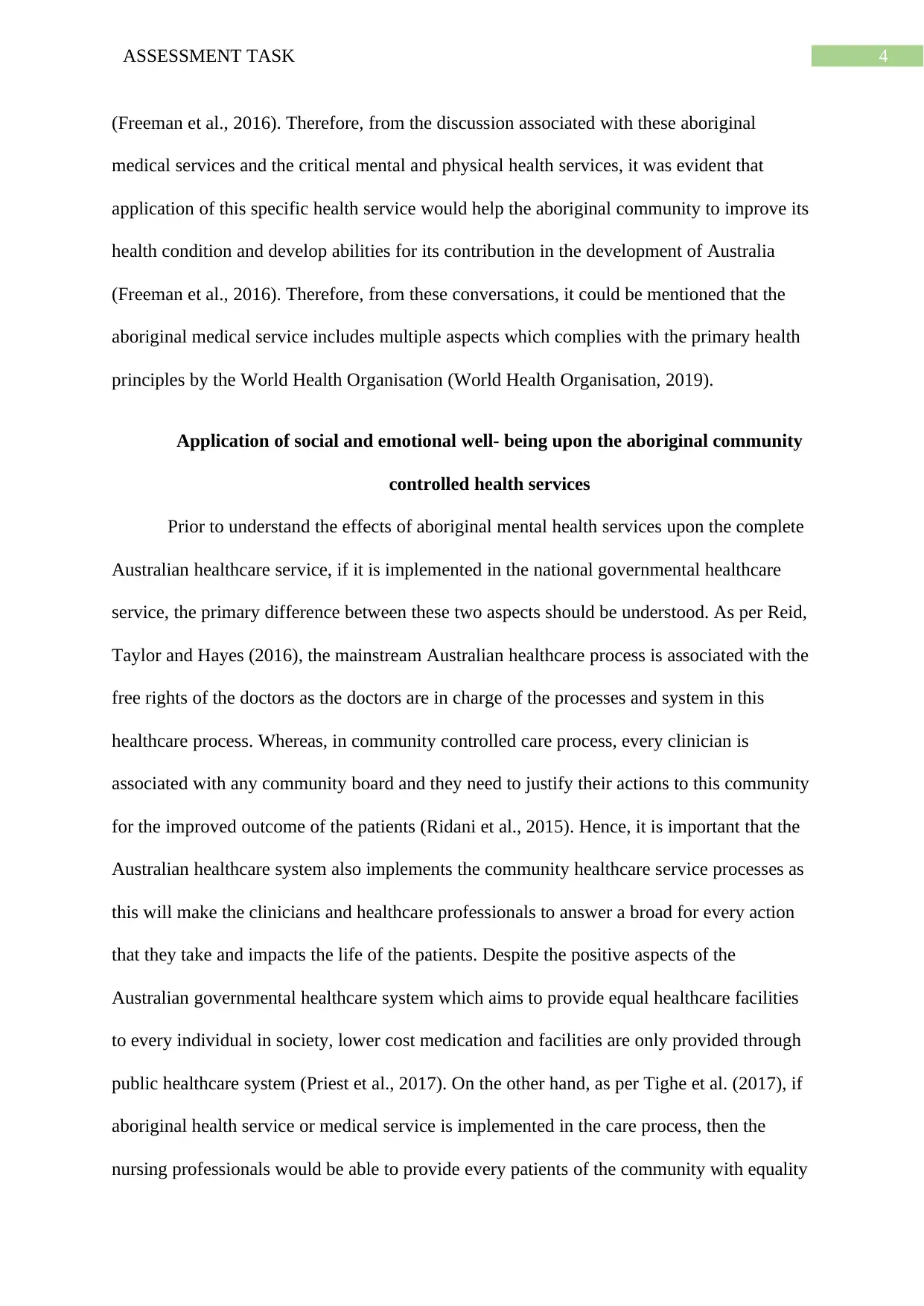
4ASSESSMENT TASK
(Freeman et al., 2016). Therefore, from the discussion associated with these aboriginal
medical services and the critical mental and physical health services, it was evident that
application of this specific health service would help the aboriginal community to improve its
health condition and develop abilities for its contribution in the development of Australia
(Freeman et al., 2016). Therefore, from these conversations, it could be mentioned that the
aboriginal medical service includes multiple aspects which complies with the primary health
principles by the World Health Organisation (World Health Organisation, 2019).
Application of social and emotional well- being upon the aboriginal community
controlled health services
Prior to understand the effects of aboriginal mental health services upon the complete
Australian healthcare service, if it is implemented in the national governmental healthcare
service, the primary difference between these two aspects should be understood. As per Reid,
Taylor and Hayes (2016), the mainstream Australian healthcare process is associated with the
free rights of the doctors as the doctors are in charge of the processes and system in this
healthcare process. Whereas, in community controlled care process, every clinician is
associated with any community board and they need to justify their actions to this community
for the improved outcome of the patients (Ridani et al., 2015). Hence, it is important that the
Australian healthcare system also implements the community healthcare service processes as
this will make the clinicians and healthcare professionals to answer a broad for every action
that they take and impacts the life of the patients. Despite the positive aspects of the
Australian governmental healthcare system which aims to provide equal healthcare facilities
to every individual in society, lower cost medication and facilities are only provided through
public healthcare system (Priest et al., 2017). On the other hand, as per Tighe et al. (2017), if
aboriginal health service or medical service is implemented in the care process, then the
nursing professionals would be able to provide every patients of the community with equality
(Freeman et al., 2016). Therefore, from the discussion associated with these aboriginal
medical services and the critical mental and physical health services, it was evident that
application of this specific health service would help the aboriginal community to improve its
health condition and develop abilities for its contribution in the development of Australia
(Freeman et al., 2016). Therefore, from these conversations, it could be mentioned that the
aboriginal medical service includes multiple aspects which complies with the primary health
principles by the World Health Organisation (World Health Organisation, 2019).
Application of social and emotional well- being upon the aboriginal community
controlled health services
Prior to understand the effects of aboriginal mental health services upon the complete
Australian healthcare service, if it is implemented in the national governmental healthcare
service, the primary difference between these two aspects should be understood. As per Reid,
Taylor and Hayes (2016), the mainstream Australian healthcare process is associated with the
free rights of the doctors as the doctors are in charge of the processes and system in this
healthcare process. Whereas, in community controlled care process, every clinician is
associated with any community board and they need to justify their actions to this community
for the improved outcome of the patients (Ridani et al., 2015). Hence, it is important that the
Australian healthcare system also implements the community healthcare service processes as
this will make the clinicians and healthcare professionals to answer a broad for every action
that they take and impacts the life of the patients. Despite the positive aspects of the
Australian governmental healthcare system which aims to provide equal healthcare facilities
to every individual in society, lower cost medication and facilities are only provided through
public healthcare system (Priest et al., 2017). On the other hand, as per Tighe et al. (2017), if
aboriginal health service or medical service is implemented in the care process, then the
nursing professionals would be able to provide every patients of the community with equality
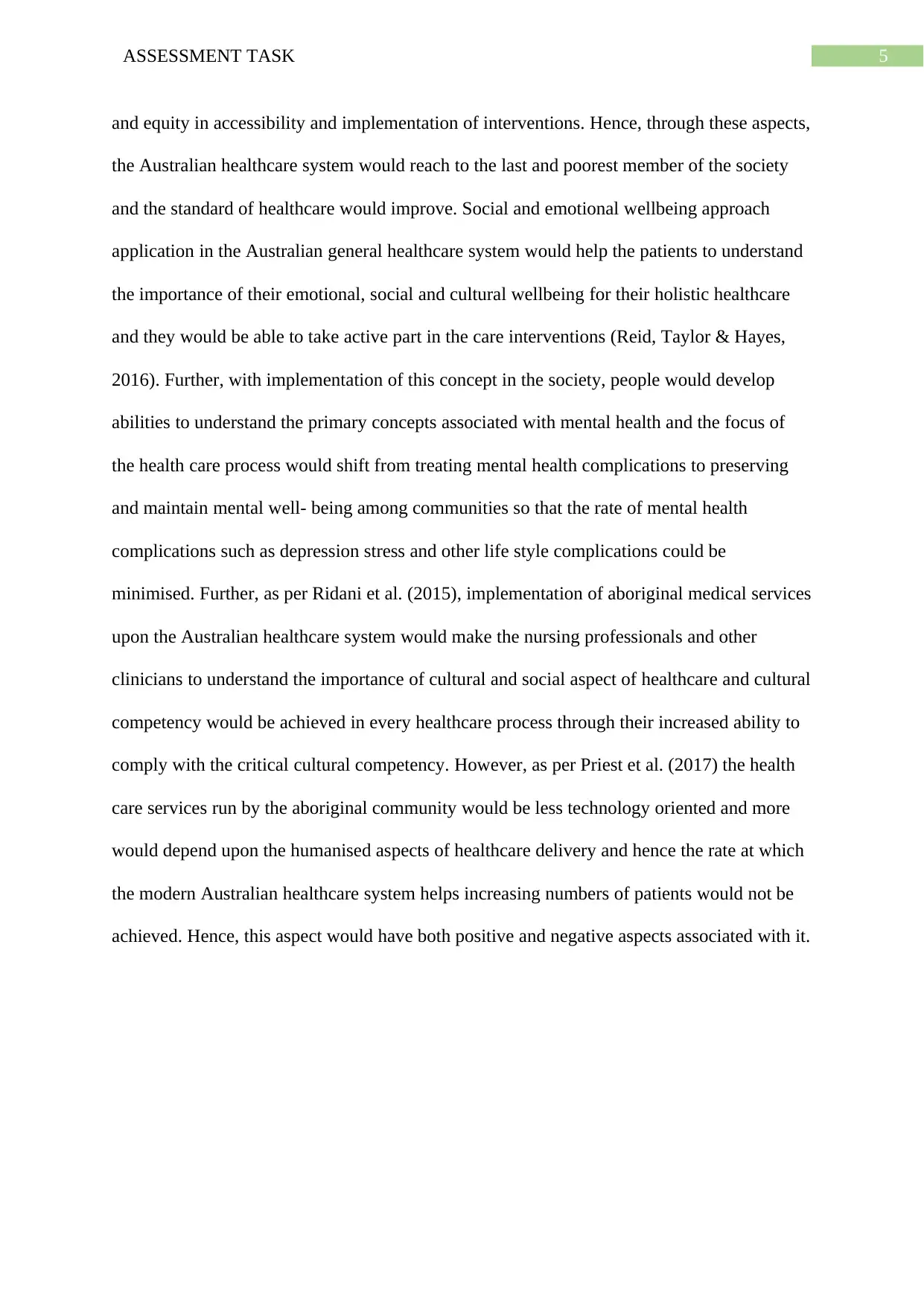
5ASSESSMENT TASK
and equity in accessibility and implementation of interventions. Hence, through these aspects,
the Australian healthcare system would reach to the last and poorest member of the society
and the standard of healthcare would improve. Social and emotional wellbeing approach
application in the Australian general healthcare system would help the patients to understand
the importance of their emotional, social and cultural wellbeing for their holistic healthcare
and they would be able to take active part in the care interventions (Reid, Taylor & Hayes,
2016). Further, with implementation of this concept in the society, people would develop
abilities to understand the primary concepts associated with mental health and the focus of
the health care process would shift from treating mental health complications to preserving
and maintain mental well- being among communities so that the rate of mental health
complications such as depression stress and other life style complications could be
minimised. Further, as per Ridani et al. (2015), implementation of aboriginal medical services
upon the Australian healthcare system would make the nursing professionals and other
clinicians to understand the importance of cultural and social aspect of healthcare and cultural
competency would be achieved in every healthcare process through their increased ability to
comply with the critical cultural competency. However, as per Priest et al. (2017) the health
care services run by the aboriginal community would be less technology oriented and more
would depend upon the humanised aspects of healthcare delivery and hence the rate at which
the modern Australian healthcare system helps increasing numbers of patients would not be
achieved. Hence, this aspect would have both positive and negative aspects associated with it.
and equity in accessibility and implementation of interventions. Hence, through these aspects,
the Australian healthcare system would reach to the last and poorest member of the society
and the standard of healthcare would improve. Social and emotional wellbeing approach
application in the Australian general healthcare system would help the patients to understand
the importance of their emotional, social and cultural wellbeing for their holistic healthcare
and they would be able to take active part in the care interventions (Reid, Taylor & Hayes,
2016). Further, with implementation of this concept in the society, people would develop
abilities to understand the primary concepts associated with mental health and the focus of
the health care process would shift from treating mental health complications to preserving
and maintain mental well- being among communities so that the rate of mental health
complications such as depression stress and other life style complications could be
minimised. Further, as per Ridani et al. (2015), implementation of aboriginal medical services
upon the Australian healthcare system would make the nursing professionals and other
clinicians to understand the importance of cultural and social aspect of healthcare and cultural
competency would be achieved in every healthcare process through their increased ability to
comply with the critical cultural competency. However, as per Priest et al. (2017) the health
care services run by the aboriginal community would be less technology oriented and more
would depend upon the humanised aspects of healthcare delivery and hence the rate at which
the modern Australian healthcare system helps increasing numbers of patients would not be
achieved. Hence, this aspect would have both positive and negative aspects associated with it.
⊘ This is a preview!⊘
Do you want full access?
Subscribe today to unlock all pages.

Trusted by 1+ million students worldwide
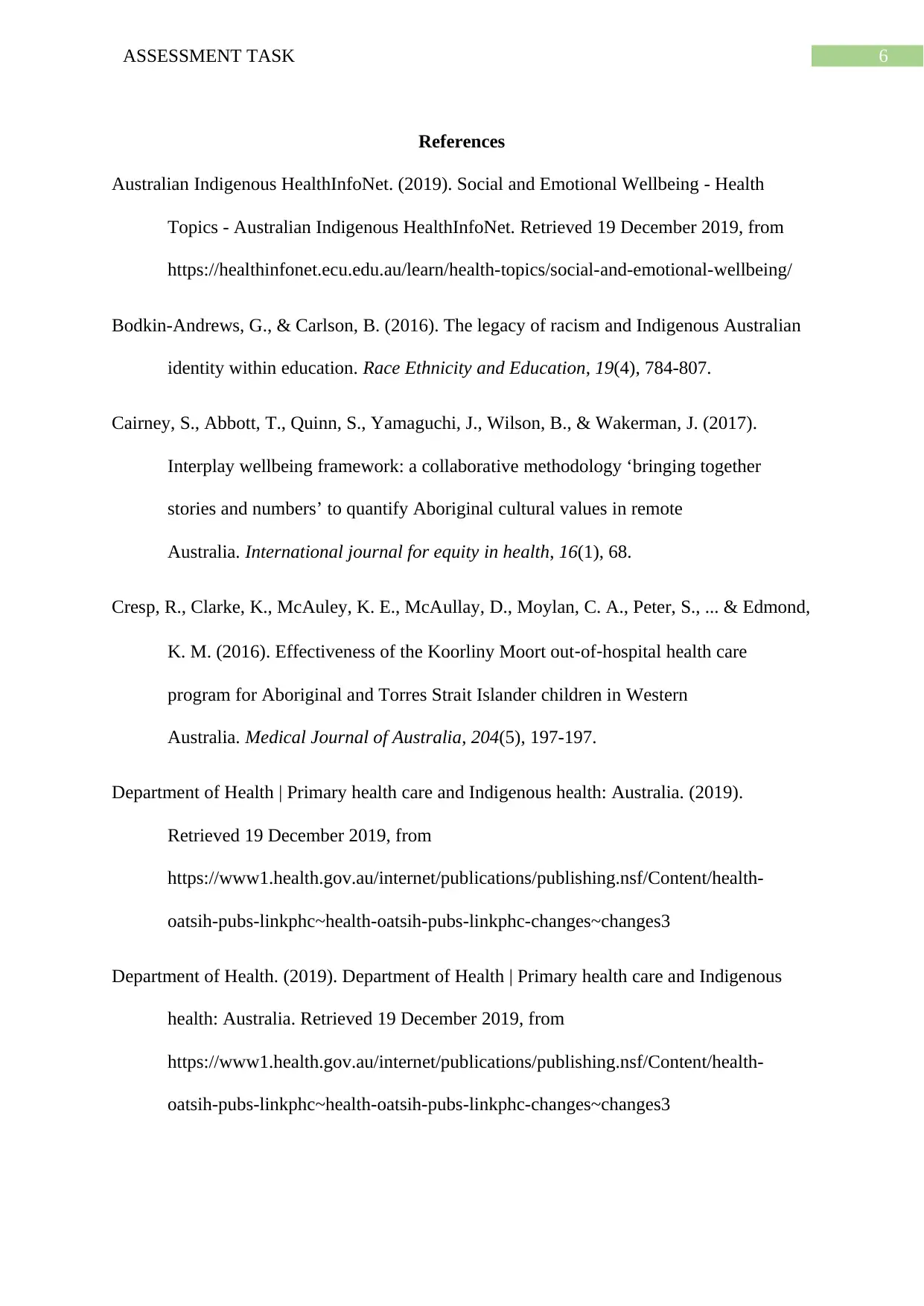
6ASSESSMENT TASK
References
Australian Indigenous HealthInfoNet. (2019). Social and Emotional Wellbeing - Health
Topics - Australian Indigenous HealthInfoNet. Retrieved 19 December 2019, from
https://healthinfonet.ecu.edu.au/learn/health-topics/social-and-emotional-wellbeing/
Bodkin-Andrews, G., & Carlson, B. (2016). The legacy of racism and Indigenous Australian
identity within education. Race Ethnicity and Education, 19(4), 784-807.
Cairney, S., Abbott, T., Quinn, S., Yamaguchi, J., Wilson, B., & Wakerman, J. (2017).
Interplay wellbeing framework: a collaborative methodology ‘bringing together
stories and numbers’ to quantify Aboriginal cultural values in remote
Australia. International journal for equity in health, 16(1), 68.
Cresp, R., Clarke, K., McAuley, K. E., McAullay, D., Moylan, C. A., Peter, S., ... & Edmond,
K. M. (2016). Effectiveness of the Koorliny Moort out‐of‐hospital health care
program for Aboriginal and Torres Strait Islander children in Western
Australia. Medical Journal of Australia, 204(5), 197-197.
Department of Health | Primary health care and Indigenous health: Australia. (2019).
Retrieved 19 December 2019, from
https://www1.health.gov.au/internet/publications/publishing.nsf/Content/health-
oatsih-pubs-linkphc~health-oatsih-pubs-linkphc-changes~changes3
Department of Health. (2019). Department of Health | Primary health care and Indigenous
health: Australia. Retrieved 19 December 2019, from
https://www1.health.gov.au/internet/publications/publishing.nsf/Content/health-
oatsih-pubs-linkphc~health-oatsih-pubs-linkphc-changes~changes3
References
Australian Indigenous HealthInfoNet. (2019). Social and Emotional Wellbeing - Health
Topics - Australian Indigenous HealthInfoNet. Retrieved 19 December 2019, from
https://healthinfonet.ecu.edu.au/learn/health-topics/social-and-emotional-wellbeing/
Bodkin-Andrews, G., & Carlson, B. (2016). The legacy of racism and Indigenous Australian
identity within education. Race Ethnicity and Education, 19(4), 784-807.
Cairney, S., Abbott, T., Quinn, S., Yamaguchi, J., Wilson, B., & Wakerman, J. (2017).
Interplay wellbeing framework: a collaborative methodology ‘bringing together
stories and numbers’ to quantify Aboriginal cultural values in remote
Australia. International journal for equity in health, 16(1), 68.
Cresp, R., Clarke, K., McAuley, K. E., McAullay, D., Moylan, C. A., Peter, S., ... & Edmond,
K. M. (2016). Effectiveness of the Koorliny Moort out‐of‐hospital health care
program for Aboriginal and Torres Strait Islander children in Western
Australia. Medical Journal of Australia, 204(5), 197-197.
Department of Health | Primary health care and Indigenous health: Australia. (2019).
Retrieved 19 December 2019, from
https://www1.health.gov.au/internet/publications/publishing.nsf/Content/health-
oatsih-pubs-linkphc~health-oatsih-pubs-linkphc-changes~changes3
Department of Health. (2019). Department of Health | Primary health care and Indigenous
health: Australia. Retrieved 19 December 2019, from
https://www1.health.gov.au/internet/publications/publishing.nsf/Content/health-
oatsih-pubs-linkphc~health-oatsih-pubs-linkphc-changes~changes3
Paraphrase This Document
Need a fresh take? Get an instant paraphrase of this document with our AI Paraphraser
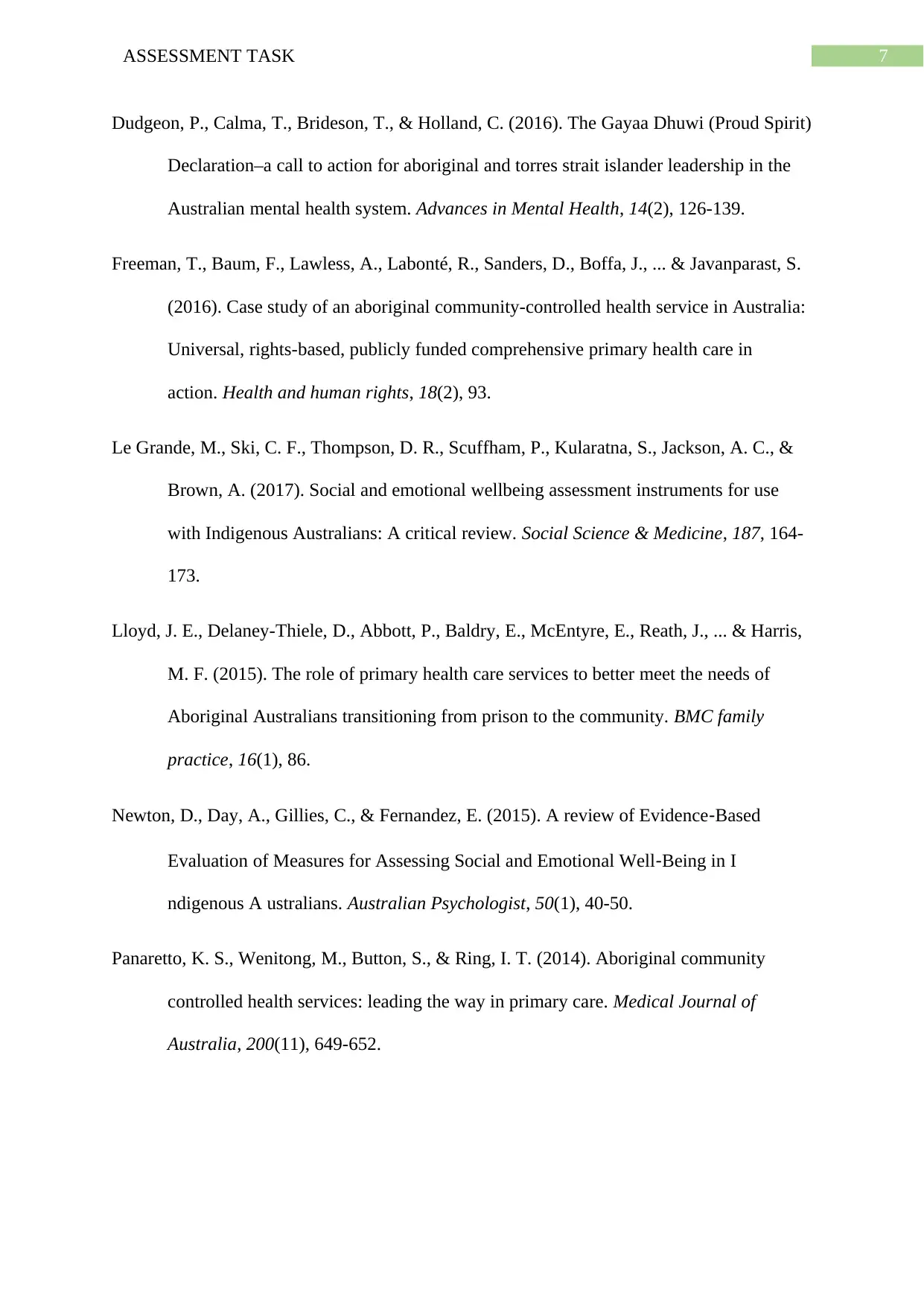
7ASSESSMENT TASK
Dudgeon, P., Calma, T., Brideson, T., & Holland, C. (2016). The Gayaa Dhuwi (Proud Spirit)
Declaration–a call to action for aboriginal and torres strait islander leadership in the
Australian mental health system. Advances in Mental Health, 14(2), 126-139.
Freeman, T., Baum, F., Lawless, A., Labonté, R., Sanders, D., Boffa, J., ... & Javanparast, S.
(2016). Case study of an aboriginal community-controlled health service in Australia:
Universal, rights-based, publicly funded comprehensive primary health care in
action. Health and human rights, 18(2), 93.
Le Grande, M., Ski, C. F., Thompson, D. R., Scuffham, P., Kularatna, S., Jackson, A. C., &
Brown, A. (2017). Social and emotional wellbeing assessment instruments for use
with Indigenous Australians: A critical review. Social Science & Medicine, 187, 164-
173.
Lloyd, J. E., Delaney-Thiele, D., Abbott, P., Baldry, E., McEntyre, E., Reath, J., ... & Harris,
M. F. (2015). The role of primary health care services to better meet the needs of
Aboriginal Australians transitioning from prison to the community. BMC family
practice, 16(1), 86.
Newton, D., Day, A., Gillies, C., & Fernandez, E. (2015). A review of Evidence‐Based
Evaluation of Measures for Assessing Social and Emotional Well‐Being in I
ndigenous A ustralians. Australian Psychologist, 50(1), 40-50.
Panaretto, K. S., Wenitong, M., Button, S., & Ring, I. T. (2014). Aboriginal community
controlled health services: leading the way in primary care. Medical Journal of
Australia, 200(11), 649-652.
Dudgeon, P., Calma, T., Brideson, T., & Holland, C. (2016). The Gayaa Dhuwi (Proud Spirit)
Declaration–a call to action for aboriginal and torres strait islander leadership in the
Australian mental health system. Advances in Mental Health, 14(2), 126-139.
Freeman, T., Baum, F., Lawless, A., Labonté, R., Sanders, D., Boffa, J., ... & Javanparast, S.
(2016). Case study of an aboriginal community-controlled health service in Australia:
Universal, rights-based, publicly funded comprehensive primary health care in
action. Health and human rights, 18(2), 93.
Le Grande, M., Ski, C. F., Thompson, D. R., Scuffham, P., Kularatna, S., Jackson, A. C., &
Brown, A. (2017). Social and emotional wellbeing assessment instruments for use
with Indigenous Australians: A critical review. Social Science & Medicine, 187, 164-
173.
Lloyd, J. E., Delaney-Thiele, D., Abbott, P., Baldry, E., McEntyre, E., Reath, J., ... & Harris,
M. F. (2015). The role of primary health care services to better meet the needs of
Aboriginal Australians transitioning from prison to the community. BMC family
practice, 16(1), 86.
Newton, D., Day, A., Gillies, C., & Fernandez, E. (2015). A review of Evidence‐Based
Evaluation of Measures for Assessing Social and Emotional Well‐Being in I
ndigenous A ustralians. Australian Psychologist, 50(1), 40-50.
Panaretto, K. S., Wenitong, M., Button, S., & Ring, I. T. (2014). Aboriginal community
controlled health services: leading the way in primary care. Medical Journal of
Australia, 200(11), 649-652.
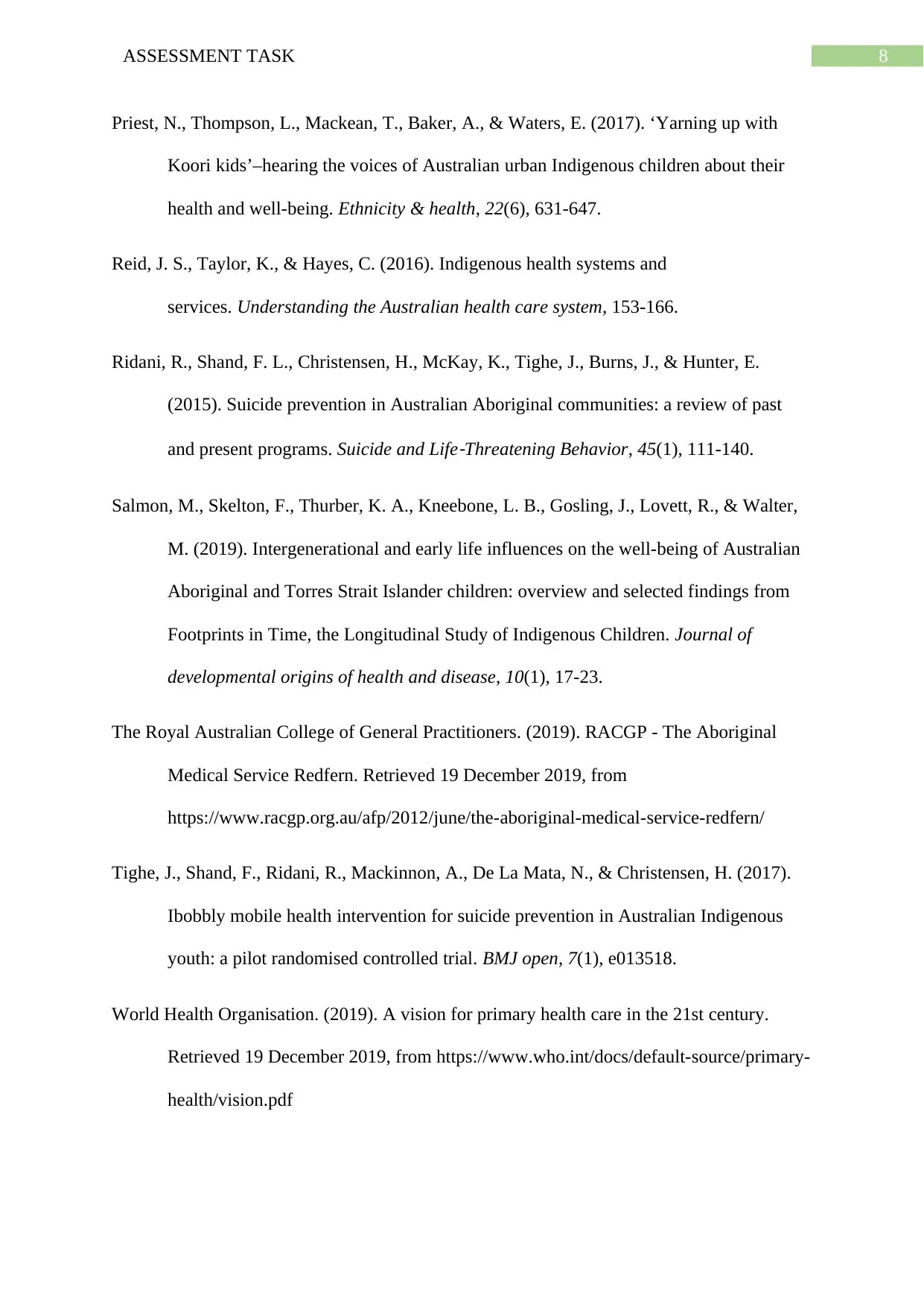
8ASSESSMENT TASK
Priest, N., Thompson, L., Mackean, T., Baker, A., & Waters, E. (2017). ‘Yarning up with
Koori kids’–hearing the voices of Australian urban Indigenous children about their
health and well-being. Ethnicity & health, 22(6), 631-647.
Reid, J. S., Taylor, K., & Hayes, C. (2016). Indigenous health systems and
services. Understanding the Australian health care system, 153-166.
Ridani, R., Shand, F. L., Christensen, H., McKay, K., Tighe, J., Burns, J., & Hunter, E.
(2015). Suicide prevention in Australian Aboriginal communities: a review of past
and present programs. Suicide and Life
‐Threatening Behavior, 45(1), 111-140.
Salmon, M., Skelton, F., Thurber, K. A., Kneebone, L. B., Gosling, J., Lovett, R., & Walter,
M. (2019). Intergenerational and early life influences on the well-being of Australian
Aboriginal and Torres Strait Islander children: overview and selected findings from
Footprints in Time, the Longitudinal Study of Indigenous Children. Journal of
developmental origins of health and disease, 10(1), 17-23.
The Royal Australian College of General Practitioners. (2019). RACGP - The Aboriginal
Medical Service Redfern. Retrieved 19 December 2019, from
https://www.racgp.org.au/afp/2012/june/the-aboriginal-medical-service-redfern/
Tighe, J., Shand, F., Ridani, R., Mackinnon, A., De La Mata, N., & Christensen, H. (2017).
Ibobbly mobile health intervention for suicide prevention in Australian Indigenous
youth: a pilot randomised controlled trial. BMJ open, 7(1), e013518.
World Health Organisation. (2019). A vision for primary health care in the 21st century.
Retrieved 19 December 2019, from https://www.who.int/docs/default-source/primary-
health/vision.pdf
Priest, N., Thompson, L., Mackean, T., Baker, A., & Waters, E. (2017). ‘Yarning up with
Koori kids’–hearing the voices of Australian urban Indigenous children about their
health and well-being. Ethnicity & health, 22(6), 631-647.
Reid, J. S., Taylor, K., & Hayes, C. (2016). Indigenous health systems and
services. Understanding the Australian health care system, 153-166.
Ridani, R., Shand, F. L., Christensen, H., McKay, K., Tighe, J., Burns, J., & Hunter, E.
(2015). Suicide prevention in Australian Aboriginal communities: a review of past
and present programs. Suicide and Life
‐Threatening Behavior, 45(1), 111-140.
Salmon, M., Skelton, F., Thurber, K. A., Kneebone, L. B., Gosling, J., Lovett, R., & Walter,
M. (2019). Intergenerational and early life influences on the well-being of Australian
Aboriginal and Torres Strait Islander children: overview and selected findings from
Footprints in Time, the Longitudinal Study of Indigenous Children. Journal of
developmental origins of health and disease, 10(1), 17-23.
The Royal Australian College of General Practitioners. (2019). RACGP - The Aboriginal
Medical Service Redfern. Retrieved 19 December 2019, from
https://www.racgp.org.au/afp/2012/june/the-aboriginal-medical-service-redfern/
Tighe, J., Shand, F., Ridani, R., Mackinnon, A., De La Mata, N., & Christensen, H. (2017).
Ibobbly mobile health intervention for suicide prevention in Australian Indigenous
youth: a pilot randomised controlled trial. BMJ open, 7(1), e013518.
World Health Organisation. (2019). A vision for primary health care in the 21st century.
Retrieved 19 December 2019, from https://www.who.int/docs/default-source/primary-
health/vision.pdf
⊘ This is a preview!⊘
Do you want full access?
Subscribe today to unlock all pages.

Trusted by 1+ million students worldwide
1 out of 9
Related Documents
Your All-in-One AI-Powered Toolkit for Academic Success.
+13062052269
info@desklib.com
Available 24*7 on WhatsApp / Email
![[object Object]](/_next/static/media/star-bottom.7253800d.svg)
Unlock your academic potential
Copyright © 2020–2025 A2Z Services. All Rights Reserved. Developed and managed by ZUCOL.




